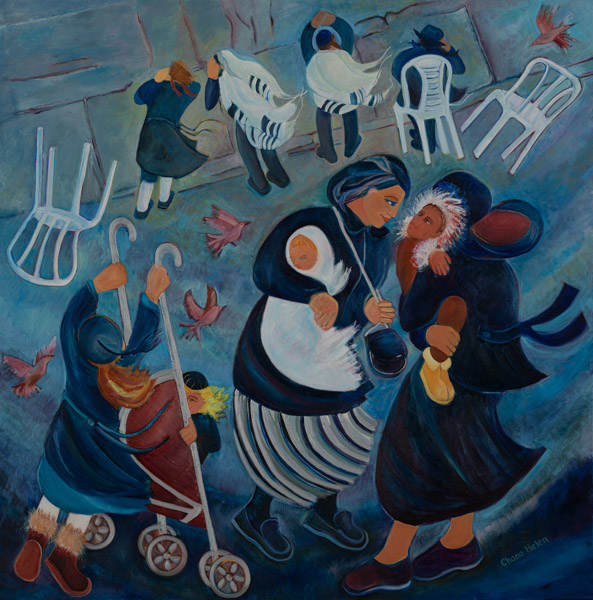
Love of Writing and Painting
Rafi Sheetrit, a writer himself, has a great love of writing and painting. In his latest book, קולמוס ומכחול (Pen and Brush) he ties these passions together.
I am very happy to be one of the 38 Israeli artists that Rafi includes in his book. Before doing so, Rafi visited me to discuss my work. Together we chose my painting, ‘Women at the Western Wall’, shown here. We excitedly talked about the story behind my work. His interpretation of my story is beautifully and sensitively written.
Rafi worked similarly with all the other artists in his book.
Joy of Writing and Painting
So now there is a beautiful hardback book in Hebrew bringing together both the joy of writing and painting. Each artist has a double page: on one page is the painting and on the opposite page is Rafi’s story about it.
June/July 2022 The paintings and the stories are on show in the Municipal Library Gallery, Beer Sheva.
Writing and Painting, Rafi’s story of my painting
Rafi Sheetrit writes in Hebrew, and I loosely I translate it into English
The Western Wall: a Remnant of the Holy Temple.
Some say that the Temple was destroyed because of unjustified hatred due to divisions and disagreements that gripped the people, and that the Western Wall was left as a witness to the calamity and an insight into its cause. Its stones remain arranged in layers; fear and heroism, destruction and resurrection.
It seems as if almost every generation has to start again from the beginning.
The Wall is still standing, but are we still divided over what should unify us? Is this the message the artist, Chana Helen, is trying to convey through her work?
I went to talk with her at her home in Be’er Sheva, where she currently lives with her husband. I returned thrilled and excited from our meeting.
The artist
The artist is a unique figure whose first stop after Aliyah was Nachla’ot in Jerusalem. Here Chana lived in a single room with a door and a window. The sunlight hardly entered her room, so she sought it in the nearby Gan Sacher park, where she would spend most of her day sitting on a bench and observing the people who create the city’s unique atmosphere.
Chana would sketch the Jerusalemites in her notebook to be later included in her many paintings, as in the work presented to us. Here we see men touching The Western Wall and praying with devotion and great intention as if only The Wall separates them from their Creator. At the same time, in the Plaza, women are present, having also come to show their devotion.
Pigeons are in flight
Pigeons are in flight and there is a quiet Jerusalem breeze. All is perfection, beauty. Another routine day in the life of the Western Wall.
I am reluctant to give a critique on, or to write about, the “artistic” side of the painting. I will, however, fulfil my mandate to pen what my eyes see on the canvas. Also, what can be observed through the small window the artist has opened for me. There are things that are difficult to see unless one pays meticulous attention to the details which appear in the painting. The details which, at first glance, may seem obscure.
I find a clear and unequivocal position of the artist regarding the place of women. That is, in the world of men, and in her own world. As an orthodox religious woman, she sees a kind of feminism in a place where one does not expect its origin at all. She expresses her position without defiance and without challenge. Rather, She expresses it by way of kindness, tolerance and commandments in the language of her paintbrush.
It is clearly visible that the men are directly in front of The Wall. Behind them are the women; the women who often must do several things at once while the men do but one thing at a time. Here the men preoccupy themselves entirely with their devotion. However, the women at the same time need to look after the children. Althoufg, this is often with the help of their daughters.
Let me comment on another detail worthy of prominence. In the religious stream, separation between women and men occurs quite naturally. Therefore, in this painting the separation takes place without any physical partitions.
As to the breeze, the light and calm breeze, we must be forewarned that it can, in a moment, turn into a storm, if we fail to expel from us the evil, the hatred, the division and the disputes.
Finally – the doves. They carry a prayer for peace for us all. Peace for all peoples, religions, people with differing religious views and for equality between the sexes.